
Pell City is a city in and one of the county seats of St. Clair County, Alabama, United States, the other seat being Ashville. At the 2020 census, the population was 12,939. At the 2010 census, the city-limit population jumped to 12,695.

The American Foursquare or American Four Square is an American house vernacular under the Arts and Crafts style popular from the mid-1890s to the late 1930s. A reaction to the ornate and mass-produced elements of the Victorian and other Revival styles popular throughout the last half of the 19th century, the American Foursquare was plain, often incorporating handcrafted "honest" woodwork. This architectural vernacular incorporates elements of the Prairie School and the Craftsman styles. It is also sometimes called Transitional Period.

The Tate House is a historic house museum at 1270 Westbrook Street, near the Fore River in the Stroudwater neighborhood of Portland, Maine, United States. The house, one of the oldest in Portland, was built in 1755 for George Tate, a former Royal Navy captain who was sent by a contractor to the Navy to oversee the felling and shipment of trees for use as masts. Because of the house's comparatively remote location away from central Portland, it survived Portland's numerous fires intact. The house was designated a National Historic Landmark as a rare surviving example of a once-common colonial housing form, the clerestory gambrel roof. Since 1935 it has been a museum operated by the National Society of the Colonial Dames.

Dallas Mill was a manufacturer of cotton sheeting in Huntsville, Alabama, United States. The first of four major textile mills in Huntsville, the mill operated from 1891 until 1949, before it was converted for use as a warehouse in 1955 and burned in 1991. The village, constructed to house workers and their families, was incorporated into the city in 1955. The mill and its mill village are listed on the National Register of Historic Places.

Chana School is a Registered Historic Place in Ogle County, Illinois, in the county seat of Oregon, Illinois. One of six Oregon sites listed on the Register, the school is an oddly shaped, two-room schoolhouse which has been moved from its original location. Chana School joined the Register in 2005 as an education museum.

North Hall was the University of Wisconsin's first building. Built in 1851 in the woods and brush that would become Bascom Hill, this one building was the UW for its first four years, housing both dorm rooms and lecture halls. John Muir resided in North Hall when he was a student at the university from 1860 to 1863.

The Octagon House in Watertown, Wisconsin, also known as the Octagon House Museum or the John Richards Octagon House, was built in 1854 and was listed on the National Register of Historic Places in 1971. It is one of many octagon houses built in the United States in the mid-19th century. In 1950 architect Rexford Newcomb wrote, "...probably the best-planned octagon house in the country is the John Richards House at Watertown, Wisconsin..."
The Hood–Anderson Farm is a historic home and farm and national historic district located at Eagle Rock, Wake County, North Carolina, a suburb of the state capital Raleigh. The main house was built about 1839, and is an example of transitional Federal / Greek Revival style I-house. It is two stories with a low-pitched hip roof and a rear two-story, hipped-roof ell. The front facade features a large, one-story porch, built in 1917, supported by Tuscan order columns. Also on the property are the contributing combined general store and post office (1854), a one-room dwelling, a two-room tenant/slave house, a barn (1912), a smokehouse, and several other outbuildings and sites including a family cemetery.
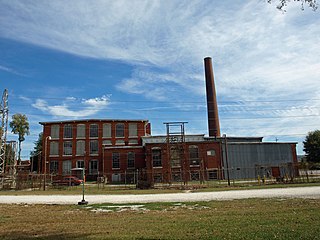
Lowe Mill is a former cotton mill of size approximately 171,000 sq ft (15,900 m2) located southwest of downtown Huntsville, Alabama.

The Suntop Homes, also known under the early name of The Ardmore Experiment, were quadruple residences located in Ardmore, Pennsylvania, and based largely upon the 1935 conceptual Broadacre City model of the minimum houses. The design was commissioned by Otto Tod Mallery of the Tod Company in 1938 in an attempt to set a new standard for the entry-level housing market in the United States and to increase single-family dwelling density in the suburbs. In cooperation with Frank Lloyd Wright, the Tod Company secured a patent for the unique design, intending to sell development rights for Suntops across the country.
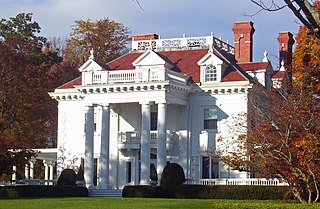
Hiddenhurst is the former estate of businessman Thomas Hidden, on Sheffield Hill Road in the Town of North East, New York, United States, south of the village of Millerton. It is an elaborate frame house built at the beginning of the 20th century in the neo-Georgian architectural style.
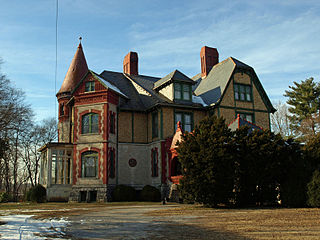
The Kildare–McCormick House is a historic residence in Huntsville, Alabama. The highly ornate, Queen Anne-style mansion was built in 1886–87. Its early owners contributed to the development of Huntsville, both through industrial projects and philanthropic efforts. The house was listed on the National Register of Historic Places in 1982.
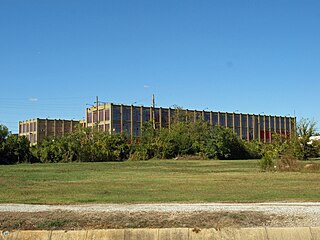
The Lincoln Mill and Mill Village Historic District is a historic district in Huntsville, Alabama. Opened in 1900, it quickly grew to be Huntsville's largest cotton mill in the first quarter of the 20th century. After closing in 1955, the mills were converted to office space that was used by the U.S. space program. Two of the older production buildings burned in 1980, but one main building and numerous houses built for workers remain. The district was listed on the National Register of Historic Places in 2010.

The Merrimack Mill Village Historic District is a historic district in Huntsville, Alabama. The cotton mill was built in 1900 by the Merrimack Manufacturing Company, reaching a peak of 1,600 employees by 1955. The mill was sold in 1946, and became known as the Huntsville Manufacturing Company. It operated until 1989 and was torn down in 1992. Houses in the adjoining mill village were built between 1900 and 1937, and encompass many mill house styles not commonly seen outside New England. The district was listed on the National Register of Historic Places in 2010.

The Michael Reade House is a historic house at 43 Main Street in Dover, New Hampshire. Built around 1780 for a prominent local merchant, it is one of the city's few surviving 18th-century buildings. It was listed on the National Register of Historic Places in 1980. It now houses professional offices.
Gladstone House and Cottage is a heritage-listed detached house at 1B–3 Gladstone Street, Newtown, Toowoomba, Toowoomba Region, Queensland, Australia. It was designed by Harry Marks for himself and built c. 1908. It is also known as St Rest. It was added to the Queensland Heritage Register on 13 January 1995.
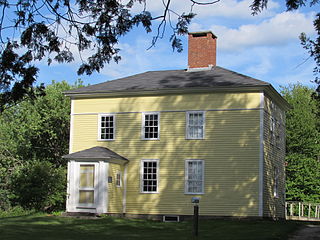
The Jonathan Fisher House is a historic house museum at 44 Mines Road in Blue Hill, Maine. The house was built in 1814 by Reverend Jonathan Fisher, the first settled minister of Blue Hill, and is now a museum dedicated to his legacy. Fisher (1768-1847) kept a journal of his life in rural Maine, and published other works, including Scriptural Animals, a work illustrated with woodcuts he created. The property was listed on the National Register of Historic Places in 1969 ; it is open seasonally between July and October.

The Ernest Edward Greene House is a historic residence in Cullman, Alabama. The house was built in 1913 by Ernest Edward Greene, the superintendent of Southern Cotton Oil Company. After Greene's death in 1922, the house was passed on to several more owners, including John George Luyben, Sr., who lived in the house for 34 years.

Opp Cottage is a historic residence in Montgomery, Alabama. T. J. and Eliza Wilson began construction on the house in 1860, but it was not completed until 1866, after it was sold to Valentine Opp. Opp was an immigrant from Austria who initially settled in Lowndes County, Alabama, and came to Montgomery after the Civil War. Opp operated a successful tailoring business. Opp's son Henry became a lawyer, the county solicitor of Covington County, and mayor of Andalusia. As attorney for the Louisville and Nashville Railroad, he was instrumental in extending the railroad through the present-day town of Opp, which was named in his honor.

Clydebank is a heritage-listed residence at 43 Lower Fort Street, in the inner city Sydney suburb of Millers Point in the City of Sydney local government area of New South Wales, Australia. It was built from 1824 to 1825 by Robert Crawford. It is also known as Bligh House, Holbeck and St Elmo. It has also served as an art gallery and as offices in the past. It was added to the New South Wales State Heritage Register on 2 April 1999.























